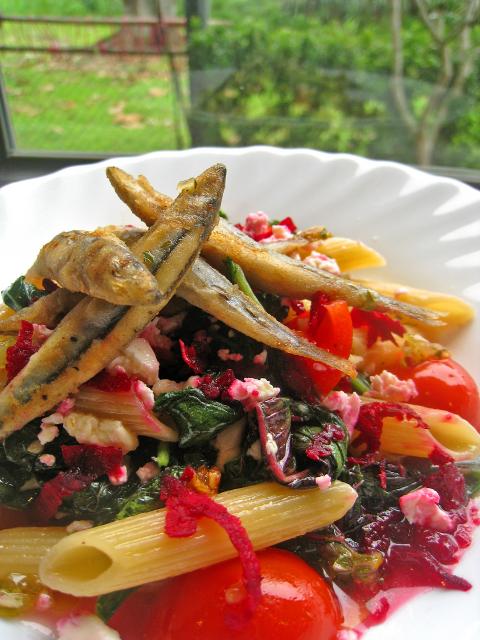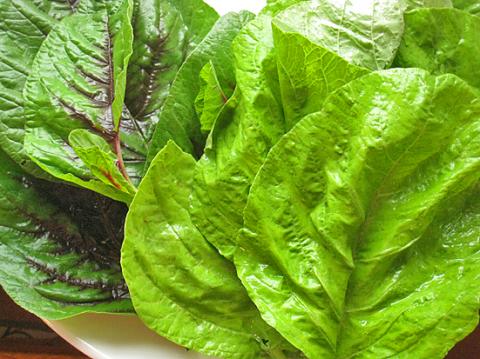Amaranth greens (莧菜) are not uncommon in markets or even in restaurant dishes such as the well-known whitebait and amaranth (吻魚莧菜), but it has never really been a high-status vegetable despite its many good qualities. Its crinkled and delicate leaves rarely look inviting on the market stall display, but they have a splendid flavor — slightly earthy, with occasional hints of sweetness — that allow them to transform a dish into something special.
Amaranth greens thrive in summer. Technically they are a herb rather than a vegetable, and they come in many different varieties, some types often growing wild. Such is the disdain for the plant that some types of amaranth are simply classified under the dismissive term “pigweed.” Such opprobrium seems excessive, for although amaranth is not much to look at, it has much else to offer.
Green and red amaranth (which has distinctive ruby red markings in the center of the leaf) are the most commonly available and are coming into season. They are a resilient vegetable, able to survive harsh conditions, and like sweet potato leaves, another cheap seasonal veg, they can generally manage to weather the heat and penitence of Taiwan’s summers without too much chemical aid. Very young shoots can be eaten raw in salads, but most of what goes on sale in the market are the more mature plants that must be cooked before eating.

Photo: Ian Bartholomew
Amaranth is a popular stir-fry vegetable. Prepared this way, with a sprinkling of chopped garlic, it yields adequate, if not exactly spectacular results. Longer cooking can yield an appealing earthy sweetness, as in the preparation with whitebait, though this dish requires a delicate touch. Overcooking or thickening of the sauce can create an unpalatable gloop, and a poorly prepared version nearly put me off amaranth in my early days of making its acquaintance.
There are over 60 species of amaranth, and while the varieties most often found in Taiwan are cultivated for their leaves, the seeds have been used as a grain for thousands of years. Amaranth grain was a central part of Aztec food and religious culture and like quinoa, it has recently acquired a certain luster as a gluten-free health food.
The leaves are also remarkably healthy to eat, packed with antioxidants, protein, vitamins, calcium, carbohydrates, iron and minerals. In Chinese medical lore, the leaves help improve eyesight and aid digestion, and Western nutrition Web sites laud the vegetable’s ability to reduce bad cholesterol, decrease the risk of cardiovascular disease and prevent calcium deficiency, in addition to fighting off cancer. Red amaranth is also touted for its richness in iron.

Photo: Ian Bartholomew
It should be borne in mind that cooked amaranth shouldn’t be reheated as the nitrates present in the leaves are converted to nitrites, which can be harmful to health, particularly in young children. In any case, it doesn’t taste very good reheated either, making it doubly something you want to eat fresh off the stove top.
Amaranth greens with penne and feta
(serves four)
This is a robust pasta that highlights the earthy flavor of its ingredients. Its vibrant colors, ease of preparation and complex taste make it perfect for a light summer meal washed down with either white wine or beer. Fresh silver-stripe round herring (丁香魚) is currently cheap and plentiful in the market and is a wonderfully sustainable and environmentally friendly fish, apart from being very nutritious.
Ingredients
Small bunch of amaranth greens, stems removed
240g penne
16 medium-sized fresh silver-stripe round herring
4 tbsp flour
2 cloves garlic, finely chopped
100ml vegetable stock
Juice of half a lemon (or to taste)
10 cherry tomatoes
15g feta cheese
Half a small raw beetroot, grated (optional)
Flat leaf parsley, finely chopped
Vegetable oil (for frying)
Olive oil (for the topping)
Salt and pepper
Directions
1. Lightly rinse the fresh herring.
2. Mix flour, salt and pepper. Coat the herring in the mixture, then dust off excess.
3. Heat vegetable oil (about 1cm deep in your pan) until hot but not smoking and fry the floured herring in a single layer. You may have to do this in two batches depending on the size of your pan.
4. Fry on each side for about one minute and until lightly golden. Remove, drain and set aside on a plate with kitchen paper to absorb the excess oil.
5. Boil a large pot of water and salt it generously. Cook the penne as instructed on the packet (usually around 10 or 11 minutes depending on the brand).
6. Meanwhile, put a generous glug of olive oil into a pan and heat over low flame. Add chopped garlic and fry until fragrant. Do not let it color.
7. Add the amaranth leaves and fry for a minute until wilted then add stock. Bring back to a simmer and add tomatoes. Reduce slightly over high heat. Season with salt and pepper. Add a splash of lemon. This should take no more than a couple of minutes.
8. Add the cooked penne and a little of the cooking water if the mixture is too dry. Toss and cook over medium heat for one minute then portion onto four plates.
9. Top with grated raw beetroot, crumbled feta, fried herrings and flat leaf parsley.
Serve immediately.
Ian Bartholomew runs Ian’s Table, a small guesthouse in Hualien. He has lived in Taiwan for many years writing about the food scene and has decided that until you look at farming, you know nothing about the food you eat. He can be contacted at Hualien202@gmail.com.

Even by the standards of Ukraine’s International Legion, which comprises volunteers from over 55 countries, Han has an unusual backstory. Born in Taichung, he grew up in Costa Rica — then one of Taiwan’s diplomatic allies — where a relative worked for the embassy. After attending an American international high school in San Jose, Costa Rica’s capital, Han — who prefers to use only his given name for OPSEC (operations security) reasons — moved to the US in his teens. He attended Penn State University before returning to Taiwan to work in the semiconductor industry in Kaohsiung, where he

On May 2, Chinese Nationalist Party (KMT) Chairman Eric Chu (朱立倫), at a meeting in support of Taipei city councilors at party headquarters, compared President William Lai (賴清德) to Hitler. Chu claimed that unlike any other democracy worldwide in history, no other leader was rooting out opposing parties like Lai and the Democratic Progressive Party (DPP). That his statements are wildly inaccurate was not the point. It was a rallying cry, not a history lesson. This was intentional to provoke the international diplomatic community into a response, which was promptly provided. Both the German and Israeli offices issued statements on Facebook

May 18 to May 24 Pastor Yang Hsu’s (楊煦) congregation was shocked upon seeing the land he chose to build his orphanage. It was surrounded by mountains on three sides, and the only way to access it was to cross a river by foot. The soil was poor due to runoff, and large rocks strewn across the plot prevented much from growing. In addition, there was no running water or electricity. But it was all Yang could afford. He and his Indigenous Atayal wife Lin Feng-ying (林鳳英) had already been caring for 24 orphans in their home, and they were in

Australia’s ABC last week published a piece on the recall campaign. The article emphasized the divisions in Taiwanese society and blamed the recall for worsening them. It quotes a supporter of the Taiwan People’s Party (TPP) as saying “I’m 43 years old, born and raised here, and I’ve never seen the country this divided in my entire life.” Apparently, as an adult, she slept through the post-election violence in 2000 and 2004 by the Chinese Nationalist Party (KMT), the veiled coup threats by the military when Chen Shui-bian (陳水扁) became president, the 2006 Red Shirt protests against him ginned up by